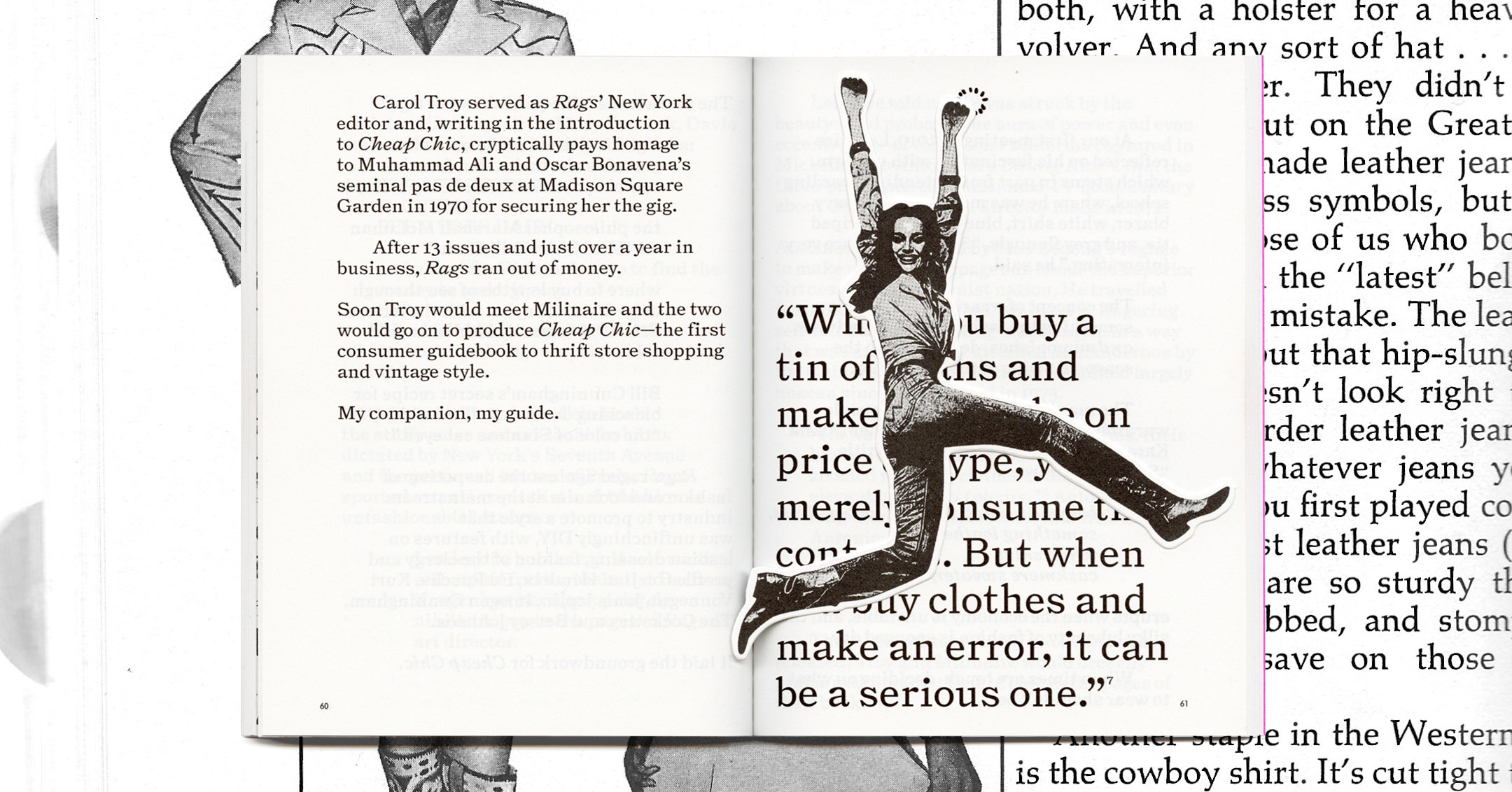Dal Chodha’s new book is an ode to 1970s fashion bible ‘Cheap Chic’
Part fan letter, part cultural commentary, Dal Chodha’s ‘You gotta keep your head straight about clothes’ (Tenderbooks) is a unique testament to fostering a personal sense of style

‘People want to control how they’re seen and I think that’s really dangerous because you can’t,’ writer, Wallpaper* contributing editor and Central Saint Martins lecturer Dal Chodha tells me over the phone from his home in London. ‘The clothes we wear used to help us know each other, but I don’t think fashion is interested in doing that anymore. That’s why we need to change how we think.’
Changing how we think about clothes is exactly what Chodha is doing in his new book, tellingly titled You gotta keep your head straight about clothes. Part fan letter, part cultural commentary, part personal history, part critical theory, the 85-page booklet suggests a new approach to how we dress by revisiting Cheap Chic, a do-it-yourself fashion manual published in 1975 by New York-based photojournalist Caterine Milinaire and writer and editor Carol Troy.
Dal Chodha’s fan letter to ‘Cheap Chic’

Chodha was first introduced to Cheap Chic 14 years ago by designer Christophe Lemaire, who appreciated its dictum of ‘personal style over fads... intelligent and measured consumption. A focus on needs, not wants.’
Cheap Chic is now Chodha’s vade mecum too, his credo for what fashion should be, the text he returns to whenever he needs inspiration, whenever he needs to get his ‘head straight about clothes.’ And, while ‘measured consumption’ and ‘a focus on needs’ suggest a sombre approach to style, the brilliance of Cheap Chic is that it blends a practical ethos with an irreverent spirit. Here is a book that suggests buying old surgical gowns because of their durable cotton, and then dying them a dusky rose, or adopting a ‘cost per wear’ system that encourages investing in clothes you’ll wear often. Uniforms are a central feature of Cheap Chic, but not the way you classically think of them. In its pages, women are photographed in leotards, cowboy boots, Mexican peasant shirts, antique smocks and army coveralls.

In You gotta keep your head straight about clothes, Chodha advocates for a revival of Cheap Chic’s eccentric utility in an era when, maybe more than ever, fashion can feel like a race to get the right brands to fit the right mould, when ‘expressing yourself’ means buying what someone else wears and calling it yours. It's a concept Chodha brilliantly and entertainingly illustrates by comparing Cheap Chic’s ‘grittier, more liquid idea of style’ to the ‘organised machine of fashion’ promoted by the 2000s British TV show What Not to Wear.
‘I’ve always loved fashion,’ Chodha tells me. ‘So I’m never a doomsayer about it. I'm able to critique it without falling out of love with it. And I think there are lots of problems with it, as we all know, but I think there's lots of problems with the world in general.’

‘It’s almost too easy to blame fashion for a lot of the stuff that we tend to blame it for,’ he continues. ‘So I hope people that read [my book] will get a bit closer to sorting out their own relationship to fashion, especially if they work in it, or if it makes them feel anxious, or if it makes them feel like shit. That’s why so much of Cheap Chic is opposed to What Not to Wear. They were so different in their approach because one basically made you feel bad for not fitting in or looking right, whereas Cheap Chic was much more about celebrating who and whatever you are.’
Receive our daily digest of inspiration, escapism and design stories from around the world direct to your inbox.
In a way, Chodha has applied that same self-exploratory ethos to his own book. His aim in writing You gotta keep your head straight about clothes was not so much to create a history of Cheap Chic as it was to explore what it meant to him. ‘I didn't bother getting in touch with Carol, Caterine or Christophe whilst writing this because that would have made it too factual and it would have taken me out of it a bit more.’

‘This is my response to this stuff, it’s a fan letter. And I like the fantasy element of situating [my ideas] in New York at the same time as these films that I love. I think that that's what's so exciting about any kind of writing that is your own.’
Indeed, You gotta keep your head straight about clothes contains a melange of cultural references, including The Eyes of Laura Mars, Diana Vreeland’s ‘Why Don't You’ column, Michelangelo Antonioni’s films of Maoist China, Roland Barthes’ The Fashion System and Terry Jones’ pictures of London punks, among others. Chodha’s witty and zealous discussions of these various topics are what makes the book infinitely readable, despite the intellectual heft behind some of its subjects. It’s the kind of book that can be consumed in one sitting and digested for days; small enough to be kept in your handbag and revisited or passed onto a friend.

‘What is interesting about this book is that there was so much reading I had to do around it that isn’t obvious, and I guess that's an important message for everybody – knowing when to back off and being okay with how small this is. I'm fine with it being this one-hour read, because I’ve been able to look at and read so much through it, and also introduced so many people to Cheap Chic who had never heard of it. That’s really the joy.’
You gotta keep your head straight about clothes by Dal Chodha is available from Tenderbooks now.
Mary Cleary is a writer based in London and New York. Previously beauty & grooming editor at Wallpaper*, she is now a contributing editor, alongside writing for various publications on all aspects of culture.
-
 Discover Locus and its ‘eco-localism' - an alternative way of thinking about architecture
Discover Locus and its ‘eco-localism' - an alternative way of thinking about architectureLocus, an architecture firm in Mexico City, has a portfolio of projects which share an attitude rather than an obvious visual language
-
 MoMA celebrates African portraiture in a far-reaching exhibition
MoMA celebrates African portraiture in a far-reaching exhibitionIn 'Ideas of Africa: Portraiture and Political Imagination' at MoMA, New York, studies African creativity in photography in front of and behind the camera
-
 How designer Hugo Toro turned Orient Express’ first hotel into a sleeper hit
How designer Hugo Toro turned Orient Express’ first hotel into a sleeper hitThe Orient Express pulls into Rome, paying homage to the golden age of travel in its first hotel, just footsteps from the Pantheon